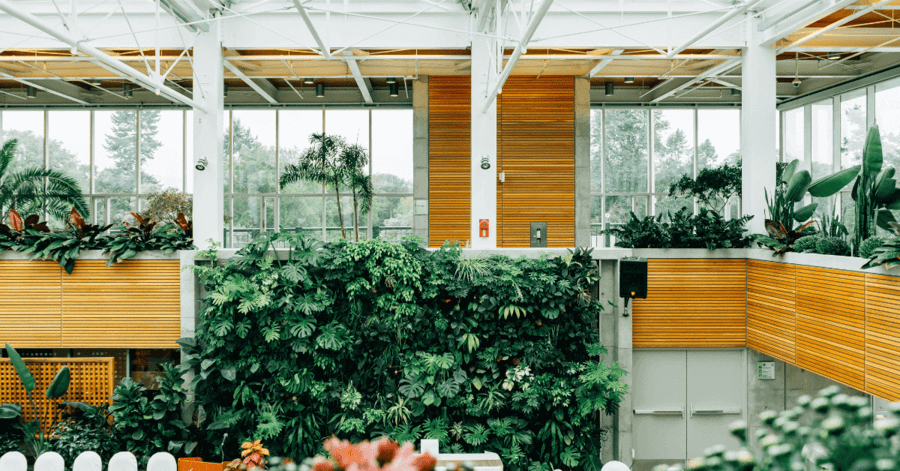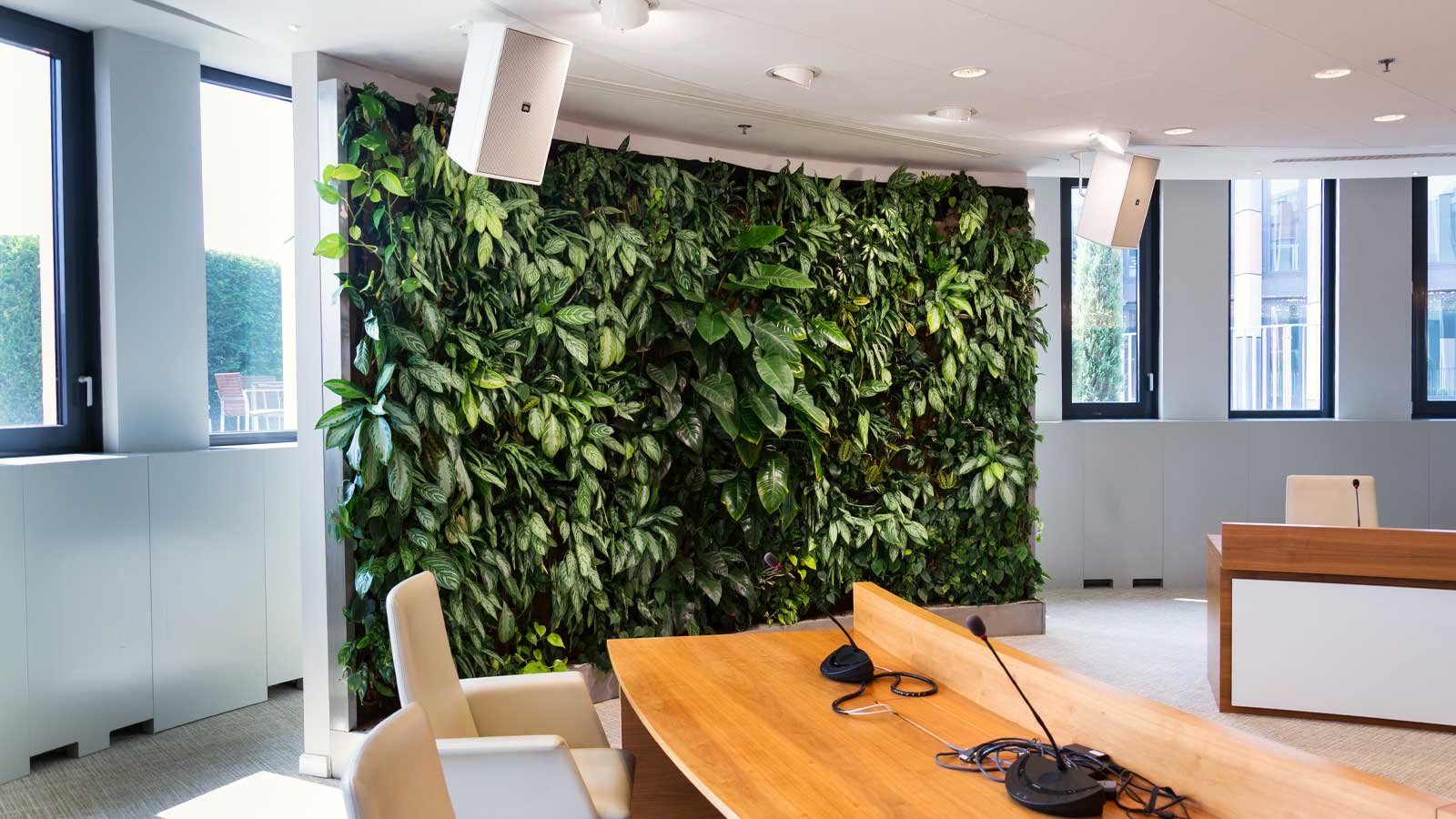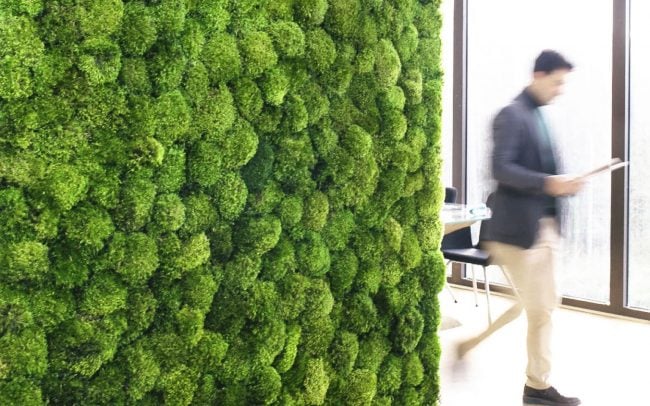Plant wall vs Moss wall: what is your right for your office

When it comes to adding greenery in your office, you have two popular options: plant walls and moss walls. Both have several benefits and can add a touch of nature to your workspace. But which one is the right choice for your office space?
You may have noticed that green walls are becoming increasingly popular in office spaces. They can bring life into an often dull office building, but apart from the stunning aesthetics, plant and moss walls are able to improve wellness and productivity in a corporate environment.
This article breaks down the differences between plant and moss walls and touches on the benefits of these brilliant biophilic design options for people in office spaces.
Plant Walls vs Moss Walls: Key differences

Plant Walls
Plant walls (also known as green walls or living walls) consist of a framework, such as a tray or a panel system, on which real, living plants are mounted. There are a wide variety of options when it comes to plant walls, whether they are indoors or outdoors, soil-based or hydroculture, modular or custom grown, we have a solution that fits your needs. Depending on the wall orientation, climate, and design intent, you can choose from a range of plant types from succulents, ferns, bromeliads, and vines.
Plant walls can be constructed to fit any space's size and shape and can be designed to incorporate lighting, irrigation systems, and other features.
Remember, before installing a living plant wall in your office space, it’s important to consult with a professional company, like Natura, who can advise you on the appropriate plant wall system, plant selections and maintenance. Unfortunately, many companies invest in a plant wall system that may look stunning at first but ultimately deteriorates due to inadequate care and maintenance.
If you’d like to know more about maintaining your plant wall, have a look at our blog: Simple ways to sustain your living walls for longer.
Preserved Moss Walls
Preserved moss are real, but non-living moss, so unlike live plants that must have suitable environmental conditions and regular care, preserved moss walls will retain their natural appearance and color for years. The only maintenance preserved moss walls need is the occasional dusting. They often create a natural and calming atmosphere in an office space and they don’t attract any pests. In addition to being easily movable, preserved moss walls can be designed in countless shapes and colors, thanks to their flexible arrangement and material (you can even install them in your ceiling).
Have a look below at some of the features and benefits of our moss walls.
Types of Moss
The moss kingdom is incredibly diverse and there are over 10 000 moss species out there. From soft cushion poll moss to striking reindeer moss, there are four types of moss that we typically incorporate into our moss wall designs.
- Reindeer Moss is the most popular type of moss we use for interior design because of its vibrant colors. From bright greens to warm yellows and orange-reds, reindeer moss is a beautiful choice for interiors.
- Pole Moss is another type of moss that we often use. Pole moss is known for its soft, fluffy appearance and is often used to provide sound absorption in large rooms, such as conference halls and auditoriums.
- Sheet Moss is a type of moss that is commonly used in green roof systems, as it helps to retain moisture and prevent erosion. Sheet moss provides a natural, organic appearance and can be arranged in attractive patterns for interior decoration.
- Mood Moss is a type of moss that is characterized by its delicate, fluffy appearance. This type of moss is often used for its aesthetic qualities, as it provides a gentle, soothing appearance and can help to create a relaxed atmosphere in a room. Soft and luxurious, mood moss can add depth to any custom design.
For more information, and inspiration, have a look at our moss art brochure.
So, which one is right for my office?
The right option for your office will depend on your specific needs and preferences. If you want a low-maintenance option that doesn't require light or water, a preserved moss wall may be the best choice. If you prefer a more diverse selection of plants and want the option to customize the wall to fit your space, a plant wall is the way to go.
Now that we’ve covered the differences between plant and moss walls, let’s take a peek at some of the benefits of these beautiful plants in an office space.
The benefits of plant and moss walls in a corporate environment
As the world continues to recover from the pandemic's effects, an increasing number of businesses are reconsidering their office spaces and seeking ways to enhance employees' well-being upon returning to work. Integrating plant and moss walls is an innovative and unique approach to incorporating nature into your office space, promoting your business, and benefiting your staff.
Studies have shown that people who work in indoor areas with plants or nature-inspired elements exhibit improved cognitive function, such as reduced stress, increased productivity, happier moods, and greater creativity.
It is clear that plants are a critical component of a productive work environment. Take a look at our infographic on the health and productivity benefits of indoor plants in your home and workplace. For a more comprehensive breakdown of the benefits of plants in the workplace, read our blog: Plants and corporate well-being: The perfect pairing.
Ready to add some greenery to your office? Schedule a call or site visit with our design team and discover the perfect plants to complement your business's unique style and needs. Let's create a sanctuary of serenity together!




